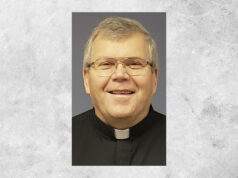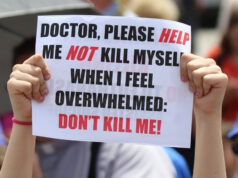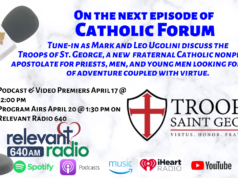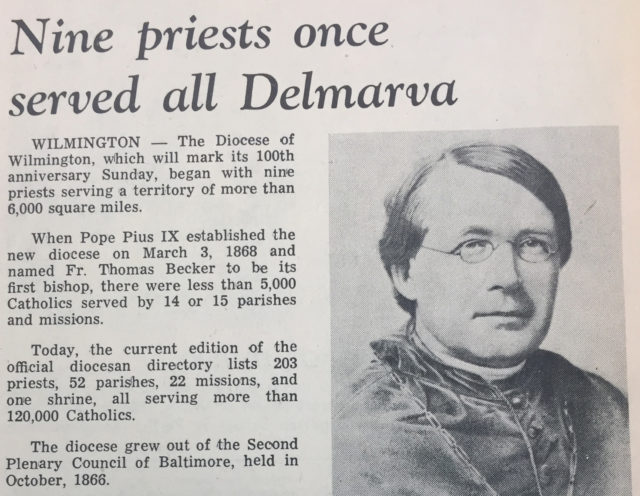
Bishops who led the Diocese of Wilmington:
Bishop Thomas A. Becker
1868-1886
Born in Pittsburgh, Pa., in 1831 and raised in the Presbyterian Church, Thomas A. Becker was received into the Catholic Church while completing his studies at the University of Virginia. Accepted as a candidate for priesthood by the Diocese of Richmond, he studied in Rome, where he became known for his piety and flair for ancient and modern languages. He was ordained in Rome in 1859, then served as an assistant pastor at St. Peter’s Cathedral, Richmond.
In 1860 Father Becker was named pastor of St. Joseph’s Church in Martinsburg, W.Va., with care of Catholics in surrounding counties. A secessionist, he was placed under arrest and transported to Washington by Union troops occupying Martinsburg in 1863. When Archbishop Francis P. Kenrick obtained his release, Father Becker was assigned to the faculty of Mount St. Mary’s College, Emmitsburg, Md., until 1864, when he was named secretary to Archbishop Martin J. Spalding.
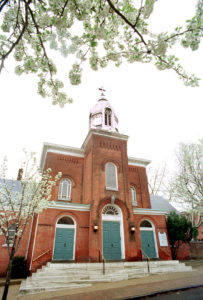
Named to Wilmington in 1868, Bishop Becker, 36 when he became the founding bishop, was known as pious, scholarly and energetic. He established 18 parishes during his 18 years leading the diocese. He also brought the Benedictine Sisters and Visitation Sisters into the diocese.
Influential on a national level, Bishop Becker was the first proponent of a national Catholic University. In 1878, in an article for the American Catholic Quarterly Review, he supported the right of labor to organize. Cardinal James Gibbons of Baltimore asked him to prepare a chapter for the third Plenary Council of Baltimore in 1884 on education of the clergy.
In 1886, at the age of 54, Bishop Becker was transferred to lead the Diocese of Savannah, Ga. He died in 1899.
Bishop Alfred A. Curtis
1886-1896
The second bishop of Wilmington, Alfred A. Curtis, holds the distinction of being the only native son to lead the diocese. Born in Rehobeth, Somerset County, Md., in 1831, he was raised an Episcopalian. Ordained an Episcopal priest in 1859, he eventually became rector of Mount Calvary Episcopal Church in Baltimore but resigned his ministry in 1871 and was received the next year into the Catholic Church in England by then-Father John Henry Newman.
After seminary at St. Mary’s in Baltimore, Father Curtis was ordained and served as the secretary for two Baltimore archbishops – James R. Bayley and Cardinal James Gibbons. When Bishop Becker of Wilmington was named Bishop of Savannah, Ga., Cardinal Gibbons replaced one Baltimore archbishop’s secretary with another.
Bishop Curtis arrived in Wilmington in 1886 at age 55. He built 12 new churches outside the city, established the Monastery of the Visitation, constructed new schools and doubled the enrollment, all while raising funds to relieve the diocese’s debt. He had fundraising in mind when he announced a lecture at the Hotel du Pont with the intriguing title “What the Irish Don’t Have.” The event sold plenty of tickets. The bishop’s revelation at his talk, according to diocesan historian Father Thomas Peterman, was that “the Irish don’t have snakes, because St. Patrick chased them out.”
Bishop Curtis resigned from Wilmington in 1896 for health reasons, according to official histories. He returned to Baltimore and served there as an auxiliary bishop and vicar general of the archdiocese. He often returned to Wilmington to hear the confessions of the Visitation Sisters. He died in 1908 and was buried at the Visitation monastery. His body now rests in Cathedral Cemetery, were it was re-interred in 1993 after the Visitation Sisters left the diocese.
Bishop John J. Monaghan
1897-1925
Wilmington’s third bishop was born in 1856 in Sumter, S.C. After studying for the priesthood at St. Mary’s Seminary, Baltimore, he was ordained for the Diocese of Charleston and was secretary and chancellor for the bishop there when he was appointed to Wilmington at age 40.
Bishop Monaghan founded nine new parishes and two missions in the diocese. He also established St. Hedwig School for the Polish immigrant population and six other parochial schools.
In 1903 he brought to Wilmington the Oblates of St. Francis de Sales, who founded Salesianum School for boys, and the Little Sisters of the Poor. St. Francis Hospital was one of Bishop Monaghan’s biggest projects; he worked for years for its completion.
The bishop was known for his friendliness and personal poverty. His last public appearance before retirement was at the laying of the cornerstone for St. Anthony of Padua Church in Wilmington in June 1925. He resigned for health reasons that August and lived in retirement for eight months at St. James Protectory for Boys in Reybold and then at St. Francis Hospital. When he died after a series of heart attacks Jan. 7, 1935, he was the oldest bishop in the United States. He is buried at Cathedral Cemetery in Wilmington.
Bishop Edmond J.
FitzMaurice
1925-1960
Edmond J. FitzMaurice was born in County Kerry, Ireland, in 1881. He studied for the priesthood in Belgium and at the North American College in Rome. After ordination he was a priest of Philadelphia, where his ministries included parish work, theology instructor at St. Charles Seminary in Overbrook, chancellor of the archdiocese and rector of the seminary.
Named fourth bishop of Wilmington at 44, his 35-year leadership saw the number of Catholics in the diocese triple, 17 parishes established, 10 missions opened, and 18 elementary and 10 high schools built.
Although most parishes and schools were already racially integrated, Bishop FitzMaurice ordered all to integrate in 1953, a year before the U.S. Supreme Court issued its Brown v. Board of Education of Topeka decision declaring separate schools for races “inherently unequal.”
Bishop FitzMaurice also promoted integration in the community at large. In a 1954 pastoral letter he said a Catholic denies the Catholic faith if he or she does not extend to all “a love of esteem reflecting our consciousness of our neighbor’s inherent dignity.”
In 1958, the National Conference of Christians and Jews honored Bishop FitzMaurice for his support of the interfaith movement.
A vigorous man, the bishop loved walking — once trekking from Philadelphia to Wilmington — and swimming, and he played golf into his 70th year. Known throughout the diocese for his kind personality, wisdom, patience, leadership and Irish wit, Bishop FitzMaurice retired at 79 in 1960. He died at St. Francis Hospital in July 1962 and is buried in All Saints Cemetery in Wilmington.
Bishop Michael W. Hyle
1960-1967
Born in Baltimore in 1901, the future bishop attended archdiocesan seminaries there and completed his theological studies in Rome, where he was ordained in 1927. As a priest of Baltimore he served at several parishes in Maryland and Washington, D.C., including becoming the first resident chaplain at St. Elizabeth Mental Hospital in Washington. He was pastor of St. Mary of the Assumption Parish in Baltimore when he was named coadjutor bishop of Wilmington in July 1958. He served as pastor of Christ Our King Parish in Wilmington until Bishop FitzMaurice retired in 1960, when Bishop Hyle was installed as the diocese’s fifth bishop on March 2.
Bishop Hyle attended the first three sessions of the Second Vatican Council (returning early from the final session due to illness), and the implementation of the council’s decrees became the focus of his episcopate. Wilmington became one of the first diocese’s to mandate parish councils and consultation systems for pastors and priests in parishes.
Bishop Hyle also founded the diocesan newspaper, then called the Delmarva Dialog, in 1965.
During his tenure Catholic social agencies were strengthened, an inner-city program was developed, and the bishop was active in understanding between religious groups and promoting civil rights.
Early in 1966, following a long-range capital building plan and diocesan development program, Bishop Hyle announced that the diocese would build a coeducational high school, St. Mark’s. He also worked to create the Newman Center at the University of Delaware.
He died at age 66 at his Wilmington residence on Dec. 26, 1967. He is buried at All Saints Cemetery.
Bishop Thomas J. Mardaga
1968-1984
Thomas J. Mardaga was born in 1913 in Baltimore, where he attended St. Ann School, St. Charles Seminary in Catonsville and St. Mary’s Seminary in Roland Park. Ordained a priest in 1940, his ministries in Baltimore included parish service, director of the Confraternity of Christian Doctrine, archdiocesan youth director and chair of the committee for the Annual Catholic Charity Fund.
Named a monsignor in 1963, he became rector of the Basilica of the Assumption in 1966 and was named an auxiliary bishop of Baltimore in 1967.
Only 14 months after he became a bishop, Bishop Mardaga was named the sixth Bishop of Wilmington on March 13, 1968, and was installed three weeks later at St. Elizabeth Church in Wilmington amid high racial tensions just days after the assassination of Rev. Martin Luther King Jr.
At Christmas that year he united with leaders of area Protestant churches in issuing a pastoral letter calling for the removal of National Guard troops from the city.
Bishop Mardaga completed the construction and opening of St. Mark’s High School and was also an advocate of the development of parish religious education programs. He created the diocese’s permanent diaconate program, started a Council of Laity and founded four parishes.
A founder of the Delmarva Ecumenical Agency, Bishop Mardaga served on the U.S. Bishops Advisory Committee and the National Council of Catholic Bishops vocations committee.
Diagnosed with cancer in 1980, he continued working for four more years before his death in May 1984. He is buried at All Saints Cemetery.
Bishop Robert E. Mulvee
1985-1995
Born in Boston in 1930, Robert E. Mulvee attended seminaries in Connecticut; Ottawa, Canada; and Louvain, Belgium, where he was ordained to the priesthood for the Diocese of Manchester, N.H., in 1957. In New Hampshire he served in parishes and as chaplain at St. Charles Orphanage in Rochester before receiving a canon law degree in 1965 from the Pontifical Lateran University in Rome.
Named chancellor of the Manchester diocese in 1972, Bishop Mulvee was appointed the first auxiliary bishop of that diocese in 1977. On Feb. 19, 1985, Pope John Paul II appointed him the seventh bishop of Wilmington.
Developing programs to increase participation of the laity in the church’s evangelization and stewardship ministries was a focal point of his time as bishop. Under his guidance, 90 percent of the diocese’s parishes participated in RENEW, a spiritual renewal program. He also laid the groundwork for the diocesan stewardship plan to challenge all Catholics to pursue their Christian vocation in parish and community life.
Bishop Mulvee also established the Catholic Development Fund to help safeguard Wilmington’s parish schools. He was active on the national level with Catholic Relief Services, the U.S. Catholic Conference and the National Conference of Catholic Bishops.
In 1995 Bishop Mulvee was named coadjutor bishop of Providence, R.I., and became the seventh bishop there in 1997. He retired from the Diocese of Providence in 2005 and is now bishop emeritus there.
Bishop Michael A. Saltarelli
1996-2008
Born in Jersey City, N.J., Michael A. Saltarelli was ordained to the priesthood for the Newark, N.J., archdiocese in 1960. His ministries included 17 years at Holy Family Church, Nutley, N.J., working in parish posts and diocesan administration until he was named an auxiliary bishop of Newark in 1990, becoming rector of Sacred Heart Cathedral. On Nov. 21, 1995, Pope John Paul II named Bishop Saltarelli the eighth bishop of the Diocese of Wilmington.
Bishop Saltarelli’s administration saw the opening of new parishes and construction of regional schools. He bolstered ministry for the growing Hispanic population and launched a $50 million capital construction campaign for diocesan and parish projects.
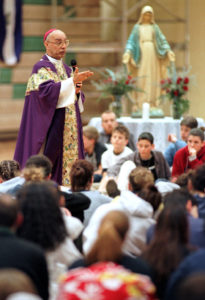
He also convened diocesan summits on vocation awareness, lay ministry and collaborative ministry. In a time of dwindling religious vocations nationally, he ordained 24 men to the diocesan priesthood. In the Jubilee Year 2000, Bishop Saltarelli presided at Sonrise 2000, which attracted 5,000 faithful to events in Ocean City, Md.
Following the 2002 revelations of clergy sex abuse cases in the church, Bishop Saltarelli established a diocesan review board for child sex abuse allegations. He also initiated “For the Sake of God’s Children,” a program to ensure safe environments for children in church activities that includes criminal background checks for personnel.
Among his writings were “How to Reach Inactive Catholics” (2000), “Catholic Schools: A Gift to the Church” in 2002; the “Litany of St. Thomas’ More, Martyr and Patron Saint of Statesmen, Politicians and Lawyers” in 2004; and a pastoral letter “Go and Teach: Facing the Challenges of Catechesis Today,” in 2005. That same year he convened the first diocesan Eucharistic Congress.
In 2008 the bishop issued a pastoral letter “Celebrating the Year of St. Paul,” in which he suggested St. Paul’s life as a model for evangelization.
Pope Benedict XVI accepted his resignation in July 2008. He died Oct. 8, 2009.







